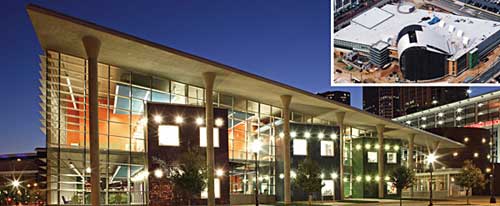What's So Cool About Cool Roofs?
Learning Objectives:
- Define a cool roof.
- Describe the benefits of specifying a cool roof.
- Identify codes or green building programs that either require or offer credit for cool roofs.
- Describe the options for cool roofing materials.
Credits:
Hip, square, flat, or pointed, cool roof products are being specified by architects to save energy, satisfy building codes and meet client expectations for comfort, cost and aesthetics. Cool roofs can be selected from a wide variety of materials and colors and can be applied to virtually any building or roof slope in any location. It is intuitive that the extent of the benefits will correlate to the building's location, type and use, as well as to the specific radiative properties of the selected roofing product. However, what may be counter intuitive is the broad range of locations in which cool roofs are proving to be a viable energy efficiency measure. Simply put, cool roofs are roofing products that integrate materials with greater spectral reflectance than their traditional, non-cool counterparts, and thereby minimize the transfer of heat to the building below. This is true for a broad range of product types, colors, textures and roof slope applications.
COOL ROOFS 101
A CLOSER LOOK AT RADIATIVE PROPERTIES
The two radiative properties that characterize cool roofs are solar reflectance and thermal emittance (see Figure on p. 2). A cool roof minimizes the solar heat gain of a building by first reflecting incoming radiation and then by quickly re-emitting the remaining absorbed portion. As a result, the cool roof stays cooler than a traditional roof of similar construction.
When sunlight hits an opaque surface, some of the energy is reflected. The measured fraction of solar energy that is reflected by a roofing material's surface is called solar reflectance, or albedo. Solar reflectance is measured on a scale from 0 to 1. High albedo, more reflective surfaces stay much cooler than low albedo, less reflective surfaces. So the higher the solar reflectance value the "cooler" the roof. Energy that is not reflected by the roof is potentially absorbed by it; this is where thermal emittance comes into play.

|
A cool roof slopes from one end of ImaginOn: The Joe & Joan Martin Center in North Carolina to the other. Construction photo in the inset shows the many ways this roofing system was installed to accomodate skylights, slopes and a flat roof surface. This project received a LEED-NC Silver rating in 2006 receiving the LEED 7.2 credit for the mitigation of heat island effects. Click on inset image to see larger details. Photos courtesy of Gantt Huberman Architects, PLLC. Photography (left) by Tom Kessler Photography. |
Â
Thermal emittance is the relative ability of the roofing material to re-radiate absorbed heat as invisible infrared light (relative to a black body radiator). This absorbed heat will either be gradually or quickly re-radiated away from the roof; the quicker the better because the longer the heat is trapped at the surface of the roof the more likely it is to penetrate the building below. Thermal emittance is also measured on a scale from 0 to 1, so a roofing material with a higher thermal emittance will re-emit absorbed thermal energy more quickly than a material with a low emittance and will result in a "cooler" roof.
Though most roofing materials have a fairly high thermal emittance, in order to accurately determine a roofing product's "coolness," or its ability to shield the building beneath it from heat, both solar reflectance and thermal emittance must be measured. It is important to note that it is possible for a roofing product to have a very high emittance value and a reflectance value ranging from very high to very low, or vice versa, although such products would not typically be considered "cool" roofs. A high emittance value alone will not result in a "cool" roof nor will a high reflectance value alone. The Solar Reflectance Index can be a useful toolfor determining the overall thermal properties of a roofing product.










